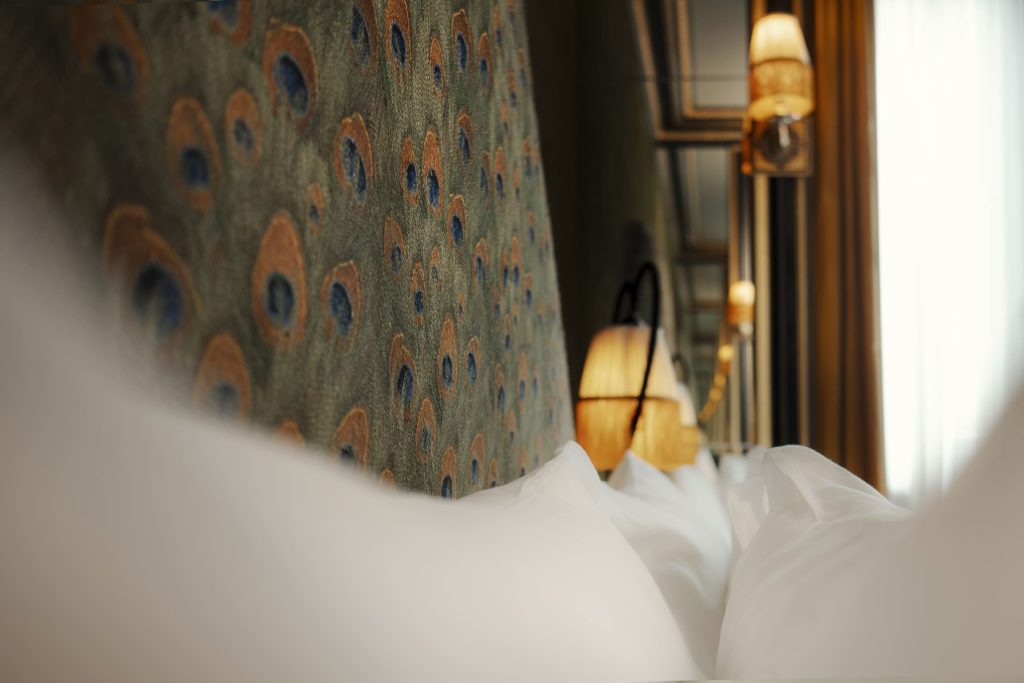
NAPOLEON III INSPIRATION
A testament to the opulence of the era, Second Empire decorative art was a profusion of forms and richness in materials. Buttoned armchairs and poufs emerged, while wall fabrics adorned with floral motifs, enhanced by gilded moldings and black lacquer, symbolized the elegance of the time. You’ll find this inspiration in the Carmen, Emma, Blanche, Mimi, Rita, and La Belle Otero rooms and suites.
Carmen
NAPOLEON III INSPIRATION
“Carmen, tall and slender, // was the fiery brunette, traditional, with whom it’s understood that one should not get bored. Moreover, a pretty girl who had been around everywhere, in Paris, in Nantes, in Marseille, and who ended up here because her child, a four-year-old, was raised on a farm…” André Dahl, Ces Dame du 12.
From this “pleasure house” in the province, Carmen enjoys the gentle atmosphere and the handsome gentlemen who, smoking and drinking, come for a bit of company. Like her companions, she holds onto the hope that one day, a happy liaison will elevate her from the state of a prostitute to an adored courtesan. A count, a duke, a prince? She dreams of grand private mansions and carriages, imagines herself adorned in lace and jewels. She knows well that to capture both the heart and mind of the man she possesses and rise in high society, one must not only be pretty but also clever and daring…
Emma
NAPOLEON III INSPIRATION
Her name is Emma Elisabeth Crouch. Born in Plymouth, England, the highest aristocrats of the Second Empire cannot resist the sharp charm of this extravagant brunette who loves money as much as carnal pleasures. In the 1860s, when she settles in Paris, Emma is determined to make a fortune by becoming a “galant woman.” She then adopts the more poetic pseudonym of Cora Pearl. Showered with riches by her numerous lovers, including Prince Napoleon, this lover of all pleasures throws numerous sumptuous parties and indulges in fantasies: during a Parisian evening at Café Anglais, she even had herself “served,” lying naked on a huge silver tray…
The decline of the Empire marks the end of the beautiful Englishwoman. After ruining a younger lover, Cora falls ill and dies at forty, forgotten by those who once idolized her. Her Mémoires conclude with these words: “I never deceived anyone because I never belonged to anyone. My independence was my entire fortune: I have known no other happiness.
Blanche
NAPOLEON III INSPIRATION
“To be mute, she spoke nevertheless to the senses,” assures Gabriel-Jules Janin when discovering Marie-Ernestine Antigny in the silent role of the statue of Helen, in Adolphe Ennery’s Faust. Like all demi-mondaines from modest backgrounds, the former circus rider from Napoleon’s circus knows that her salvation lies only on the stage. If her acting proves mediocre, her generous curves are noticed: from then on, the pretty blonde is renamed Blanche d’Antigny and mingles with the cream of Russian aristocracy who shower her with jewels, fur, and rubles.
Her revelries make headlines, her dissolute life fascinates: but the voluptuous courtesan does not resist her creditors for long who, despite her wealthy suitors, make her flee to Alexandria where she performs on stage in 1873. Back in Paris, ill, abandoned by all, Blanche dies at the age of 34. Her premature end inspired Emile Zola for the character of Nana.
Mimi
NAPOLEON III INSPIRATION
Alfred de Musset loves his Mimi Pinson with her upturned nose, pretty teeth, her round face under the little bonnet…
“Mimi Pinson is a blonde,
A blonde that one knows.
She has only one dress in the world,
Landerirette!
And only one bonnet.
When a good supper awakens her,
She sings out the song F
rom the bottle. S
ometimes it tilts over the ear,
The bonnet of Mimi Pinson. …”
Alfred de Musset
Rita
NAPOLEON III INSPIRATION
LA BELLE OTERO
NAPOLEON III INSPIRATION
“Fortune comes while sleeping. As long as you don’t sleep alone,” proclaimed La Belle Otero…
Endowed with a fiery temperament, viscerally independent, and dreaming of glory, Caroline Otero Iglesias doesn’t stay long in Spain, where she grew up in impoverished surroundings. Her charm, mischievous smile, and grace gave her performances as a dancer and actress an irresistible force. Her career was dazzling: retaining her stage name, La Belle Otero embarked on triumphant tours across Europe, America, and Russia, enchanting the most prominent figures of the Second Empire’s high society—Edward VII, Leopold II of Belgium, the Duke of Westminster, the minister Aristide Briand, and even the writer Gabriele d’Annunzio. Thanks to the pioneer of cinema, Félix Mesguich, who filmed her dancing in Saint Petersburg in 1898, she even became “the first star in the history of cinema.”
It’s been said that the rounded forms of the domes of the Carlton Hotel in Nice were inspired by the curves of the beautiful Spaniard’s breasts…

